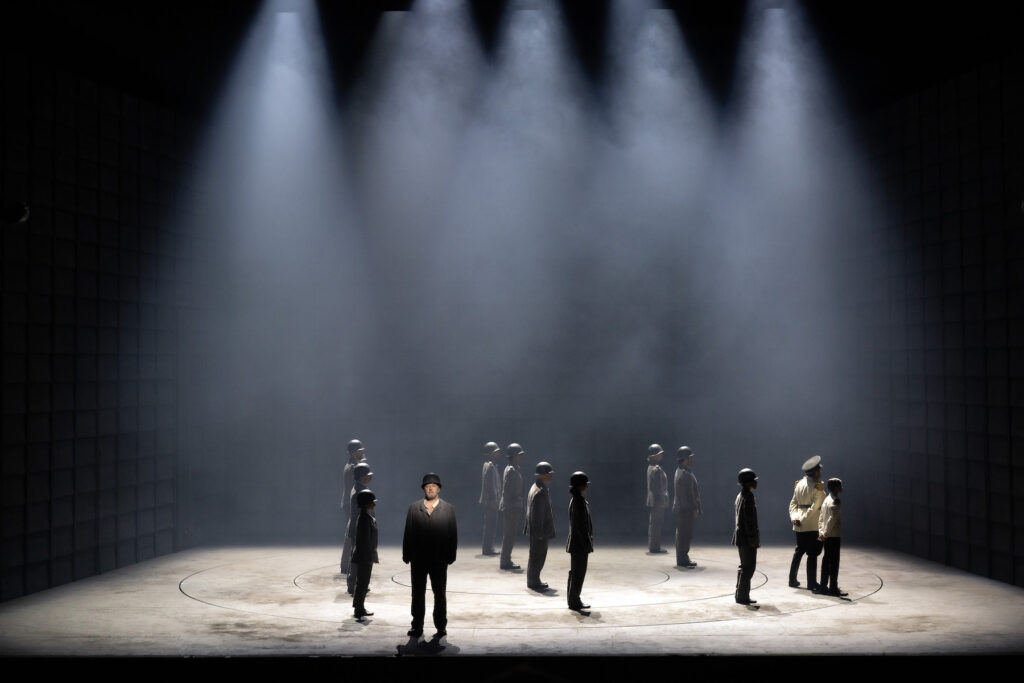Finally! Cancelled in 2003 by a strike, postponed in 2020 by Covid, Alban Berg’s expressionist masterpiece Wozzeck has just been given 5 performances at Aix’s Grand Théâtre de Provence — though the clear skies and brilliant sunshine of Provence made dark, middle European depressive thinking seem irrelevant.
Wozzeck is only the fourth opera ever staged by famed British theater director Simon McBurney, all four at the invitation of Pierre Audi, now head of the Aix Festival — both The Magic Flute and The Rake’s Progress originated in Amsterdam, then traveled to the Aix Festival in 2014 and 2017 respectively. Heart of a Dog, from Amsterdam as well, came to the nearby Opéra de Lyon in 2014.
Famed Canadian designer Michael Levine created the quite brilliant settings for the first three operas.
This McBurney Wozzeck originates in Aix, and will surely travel to theaters around the world. There is however a new designer, German born, London based Miriam Beuther who brings an appropriate darkness to the oppressive bleakness of the Georg Büchner play as deepened by Alban Berg. It was a huge dark brown box in which sat a very small doorframe that moved here and there on a revolving floor. All this minimalism, with copious use of theatrical fog, created the one, single atmosphere for the 15 scenes of the Berg opera.
Wozzeck is a sung play, its words immeshed in a complex musical scheme that invites scrupulous analysis while demanding a fully persuasive actualization. Famed conductor Simon Rattle joined Mr. McBurney to create these Aix performances. Rattle first approached the work in a 1988 production at Los Angeles Opera noted for the passion and clarity of its musical realization. Just now in Aix, 35 years later, he brought Romantic sweep and grandiose gesture to the formidable presence of the London Symphony Orchestra. In his sweep to the famed B natural crescendo that marks Wozzeck’s murder of Marie, Rattle overrode Berg’s careful, precise compositional structures. The monotone B rose to a volume never before achieved in any opera house or concert hall anywhere on earth.

McBurney landed on a single gesture to define Wozzeck’s world. The first scene of the opera was no longer Wozzeck shaving the captain, instead it was platoon of soldiers in a strict formation from which Wozzeck had been pulled. The captain jabbed at Wozzeck with his finger while ranting about the private’s moral failures, the captain’s same jabbing motions were echoed by an identically dressed, miniature captain, a boy the same age (9 or so) as Wozzeck’s soon to be revealed bastard son.
In the end, the famous “hop, hop” was sung by the miniature captain boy, jabbing now at Wozzeck’s son who was silently, blankly standing where Wozzeck had silently and blankly stood in the opening scene. See lead photo.
Slick theater indeed.
Wozzeck had been the brunt of the doctor’s tortures, his common law wife’s humiliations, the drum major’s innate prowess and the revelers’ indifference. There was no respite, the captain and the doctor did note that someone was maybe drowning just as Wozzeck was sinking, theatrically, through the floor of the stage. It was the rapid, inexorable and final destiny of a common man.
Berg was nowhere to be found, the famed musical elaborations of the interludes were lost in the a vista musical sweep of the production. The extended, purely musical moments when Berg and the spectator were offered participation were obliterated in the creators’ enthusiasm for making compelling theater.

As is the norm at the Aix Festival the casting perfectly supported the specific musical and theatrical aspirations of this Simon Rattle / Simon McBurney production. Wozzeck was sung by famed German lieder singer Christian Gerhaher, Marie was sung by Swedish soprano Malin Byström, the Hauptmann was sung by Welsh baritone Peter Hoare, the doctor by British bass Brindley Sherratt, the Drum major was sung by Belgian tenor Thomas Blondelle.
Andres was sung by Welsh tenor Robert Louis, a member of the Opera Studio of the Opéra de Lyon. Margret was sung by French mezzo Héloise Mas, the Opéra de Marseille’s recent Carmen. The Estonian Philharmonic Chamber Choir served as the chorus, the Maîtrise des Bouches du Rhône was the children’s chorus.
The complex production required a large number of non-singing roles and a lively on-stage banda to make the second act tavern scenes slickly theatrical. There were, of course, huge video images projected onto the walls of the stage box that were gratuitous. Lighting was designed by Paul Anderson, costumes were designed by Christina Cunningham, both frequent Simon McBurney collaborators, whose brother Gerald served as the Wozzeck dramaturge.
Michael Milenski